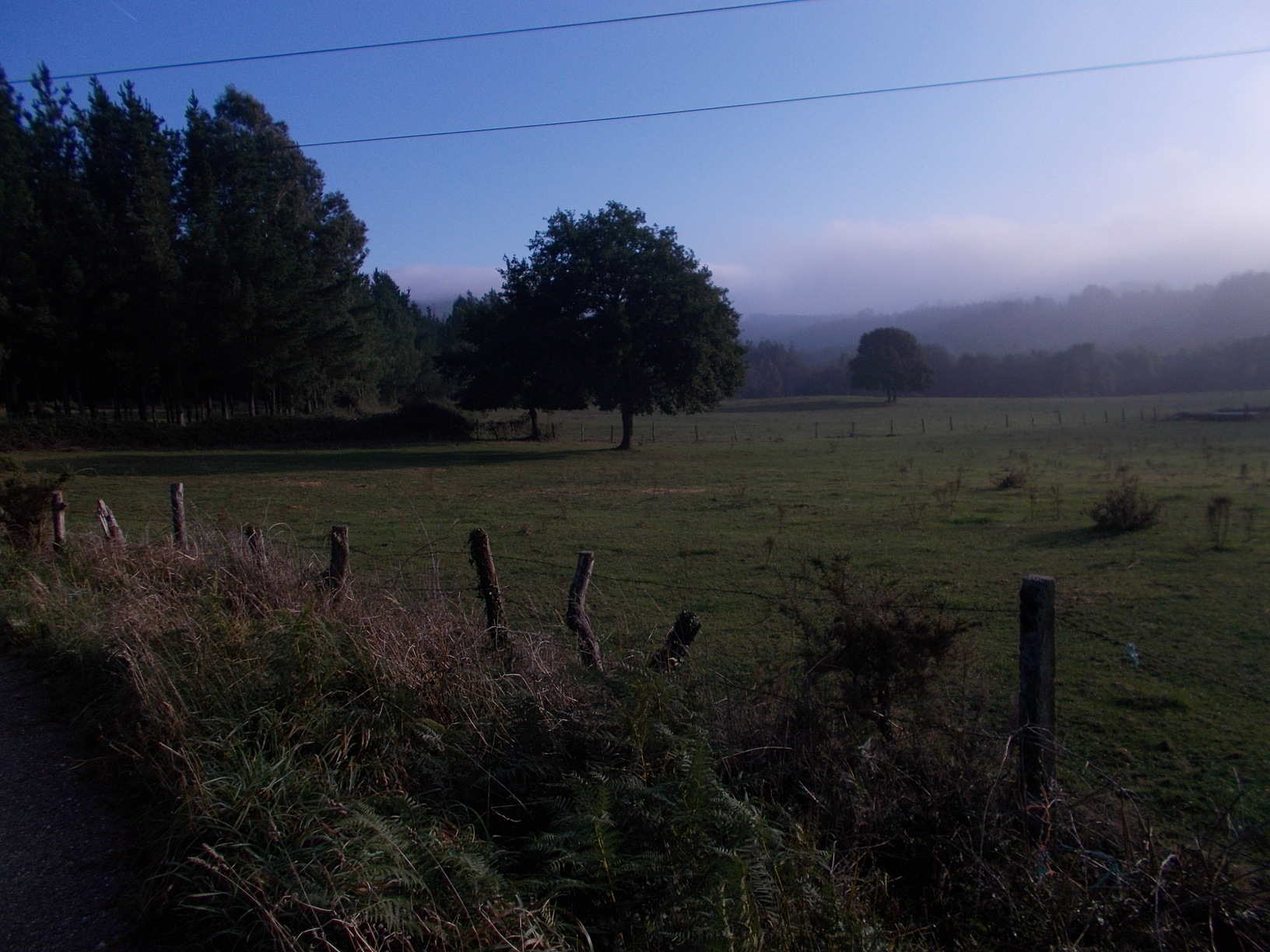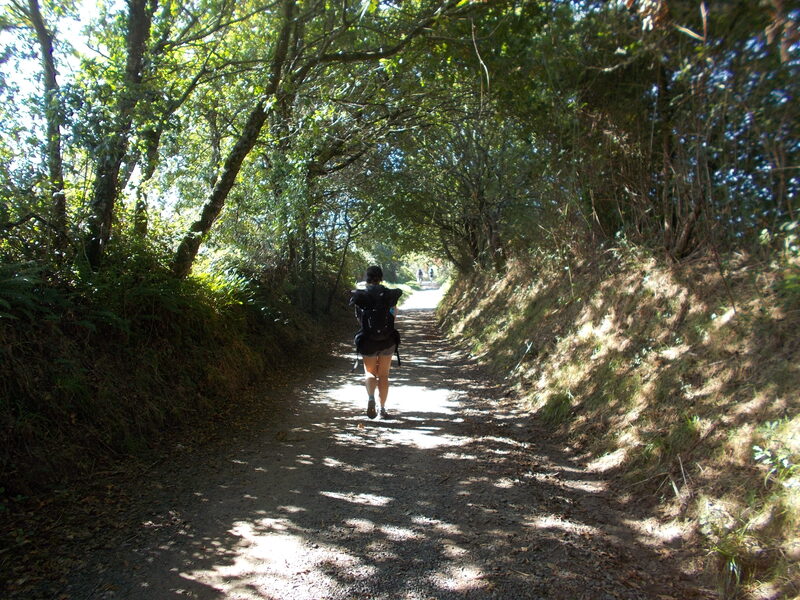Camino Portuguese is a great way for “Camino beginners”. Whether you pick the coastal route or the inland one, the distance from Porto to Santiago is just about 250 kilometers, the terrain is mostly flat, and you can do this walk in 10 days. In my personal experience, Portuguese caminos aren’t as rich in natural beauty and cultural heritage as Spanish caminos, but they have their special charm, and they are definitely worth doing. But what’s the best time of the year to walk Camino Portuguese? We will try to find the answer on the following lines, explaining the advantages and disadvantages of every season. Let’s start with the high season.
Table of Contents
July and August have less rainy days than the rest of the year
If you do not mind walking in a hot weather (which can be quite a struggle especially on many tarmac and asphalt routes you will follow along the coastal camino, the so called “Camino Litoral”), and you absolutely hate rain, you should head to the Camino in July and August. Statistically speaking, it rains in average just 2 days in July and 2 days in August in Porto (the stats are similar from other cities along the way, such as Ponte de Lima or Tui), so you can almost forget your poncho back at home. We’ll talk about precipitation in other seasons later on, but for example in May, which is a popular month on Camino Portuguese, locals experience in average 9 days of rain, so the chances of having to walk in rain are much higher.
Having said that, high summer season still has some drawbacks. First of all, the infrastructure on this Camino isn’t as dense as it is along the French way, or Camino del Norte. Albergues fill up pretty quickly in summer, and unless you book in advance or are adventurous enough to improvise (sleeping in the open, asking locals for shelter, etc), you may experience unnecessary stress on your camino. You should also remember that during the holiday seasons many Spanish and Portuguese students head out on the Camino. It is great if you are up to for a party atmosphere, but if you are looking for a more spiritual experience, you better go in spring or autumn. Let me sum up pluses and minuses of walking Camino Portuguese in July and August:
- Pluses: almost no rain, everything is open along the way, sea is warm enough for a short swim at least, many young people around, availability of local fruit delicacies such as fresh figs.
- Minuses: pilgrim hostels can get crowded easily and you may struggle finding accommodation on a day, on hot days with humidity in the air it is especially hard walking on asphalt roads close to the sea, party atmosphere along the Camino (which can be both plus and minus, depending on what you are looking for on your pilgrimage).
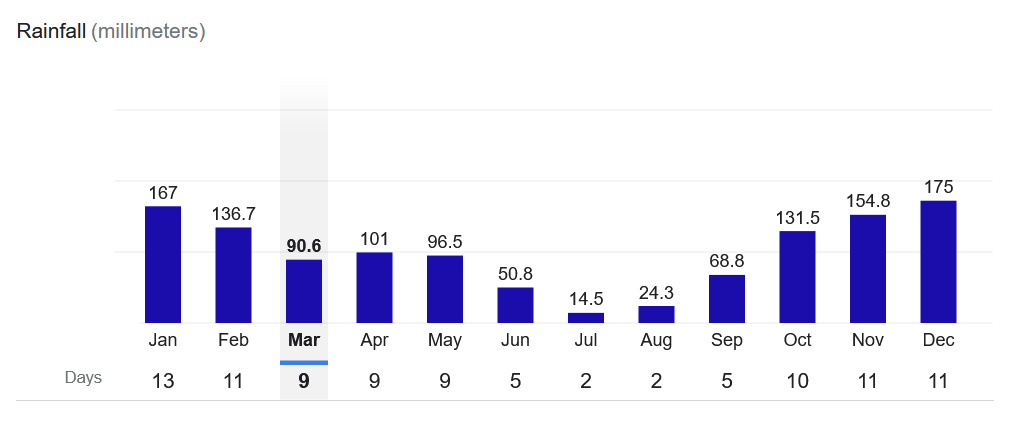
– Rainfall by month in Porto. You can clearly see it almost doesn’t rain in July and August, which cannot be said about other months of the year. Source: Google weather
* May also interest you: Where to get a pilgrim passport in Porto?
Walking Camino Portuguese in spring, from late March to mid June
Many people start their Camino Portuguese in spring. Portugal is a green country. If you opt for a central route (either all the way from Lisbon or from Porto), you’ll enjoy a variety of blooming flowers and trees, and the scents characteristic for maritime countries. The air is much more pleasant for walking, and so is the temperature. Mornings are relatively cold (which isn’t bad for walking), but even during the day the temperature rarely exceeds 20 degrees Celsius in April or May. With the powerful Portuguese sun, you’ll feel great walking in your t-shirt and at the same time you won’t be soaked with sweat.
The drawback of spring walking is the rain, of course. If a country is green, it means it rains often, at least in certain seasons of the year. Portugal is no exception to the rule. Bearing in mind that it rains in average 9 days in April and May, you will need your rain jacket. In this case it is actually a drawback that the Camino Portuguese is relatively short. Because if you happen to catch a span of bad weather, it can easily happen that out of ten days of walking you have quite some rain on seven. Of course, if you are flexible with time and can do some planning, you can adjust your starting day to the weather forecast, and avoid a rainy pilgrimage. Let me summarize a few pluses and minuses of walking Camino Portuguese in spring.
- Pluses: great temperature for walking, flowers blooming everywhere (especially on the central route), mostly “real pilgrims” on the way (instead of summer “turigrinos”), most pilgrim places are open already.
- Minuses: it can get rainy for several days in a row, some tourist places and restaurants in smaller cities will still be closed, if you are unlucky it can happen that you walk almost alone (especially in March and first half of April), it is impossible to swim in the sea (unless you are Wim Hof of course).
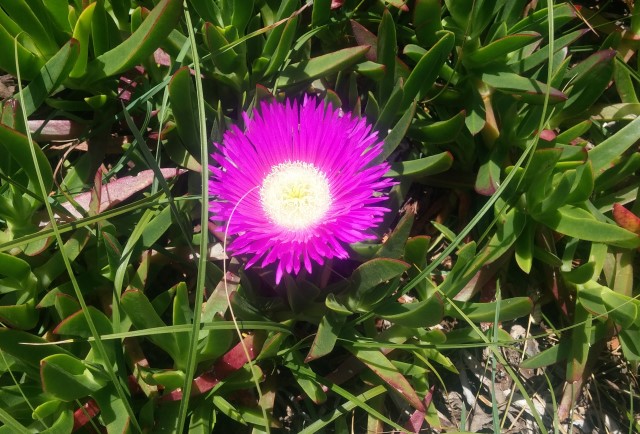
– One of the many beautiful flowers you can spot while walking Camino Portuguese in spring. I took this picture in late May 2016, on the 3rd day of my camino from Porto to Santiago
* May also interest you: Camping on the camino – is it legal and possible?
Walking Camino Portuguese in Autumn (September and October)
If you prefer to restrain from the crowds and perhaps hope to escape cold weather in your country and prolong your summer for a bit, walking Camino Portuguese in September or first half of October isn’t a bad idea. The temperature is still quite warm, especially in September. On some years actually September can be even warmer than August. 90% of pilgrim places, restaurants and hotels are open, but the crowds are already gone. Hence you can enjoy a pleasant and stress-free Camino, without racing for beds or waiting for thirty minutes for a waiter to notice you in a crowded restaurant.
Of course, it also has some drawbacks. The countryside is more dry, you won’t see the flowers as you’d see in spring, and it rains more often than it does in July or August (October has already 10 rainy days in average in Porto). What may surprise you is that the ocean is still decently warm, and many people enjoy a short swim in it while following the coastal route. All in all, I’d say this is a great time to do the Camino Portuguese, and a season which is underestimated by many. Let’s have a look at major pluses and minuses:
- Pluses: pleasant weather, almost everything is still open, ocean still warm enough for a swim, you don’t have to race for beds.
- Minuses: More rainy days (especially in October), countryside doesn’t have the lush beauty it has in spring and early summer, mornings get quite cold.
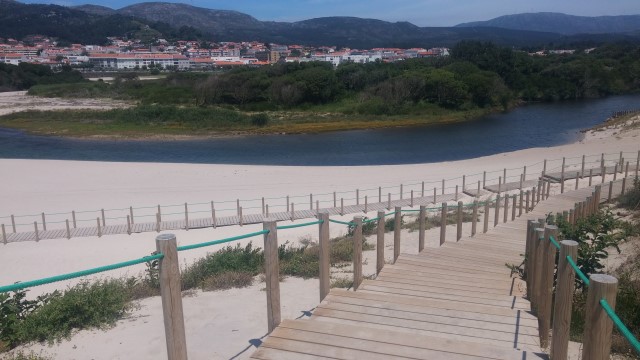
– You’ll follow these “wooden paths” a lot on coastal route of the camino (Camino Portuguese Litoral). Though they make for nice sights and pleasant walking experience, on some occasions I would prefer walking on the sand…
Walking Camino Portuguese in the off season (from November to mid March)
Each of us has their own preferences and reasons for walking the Camino. If rainy weather suits you and you are looking for solitude and time to reflect on life, walking in the off season is an option. Portugal is a coastal country, and it never gets really cold there. Temperature just rarely drops below 5 degrees in winter (in the morning), and even in December or January it isn’t unlikely to enjoy pleasant 15 degrees Celsius in the afternoon. However, you have to count with a lot of rain, including heavy and persistent rainfall on some days. Sure, you may be lucky, but also unlucky and get soaked almost every day. So keep it on your mind when planning your pilgrimage.
One thing many pilgrims underestimate is the shrinking of infrastructure when we compare it to summer months. Many places do not find it profitable to remain open in the off season and so they close down in winter. Of course, you won’t find it hard getting a bed and a meal in Porto. But many small cities on the coast turn almost to ghost towns in winter, and hence any off-season camino requires some planning. Check the route in advance, call to places making sure they remain open, and make sure that you won’t end up sleeping in the street on a rainy night in January… Let’ move to main pluses and minuses of walking Portuguese in winter:
- Pluses: great for solitude and reflection, good temperature for walking.
- Minuses: very few pilgrims around, many pilgrim hostels and even restaurants are closed, long stretches of rainy weather are pretty common, it is necessary to plan your walk in advance (due to limited opportunities for a bad for a night).
Final thoughts
In my opinion, there’s nothing like a perfect time to walk this or that Camino. Each season and each month of the year has its specifics. It really depends on what you are looking for on your pilgrimage, what weather you like, and whether you prefer solitude or company along the way. I hope my post helped you understand the specifics of each season on Camino Portuguese, and I wish you a wonderful pilgrimage!
Matej
May also interest you:




![Ultralight Packing List for Camino de Santiago [2025 Edition]](https://caminolovers.com/wp-content/uploads/2022/03/altra-shoes-640-x-480.jpg)

